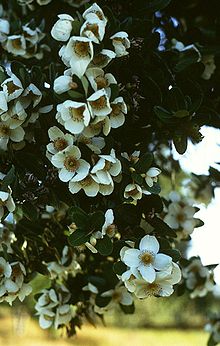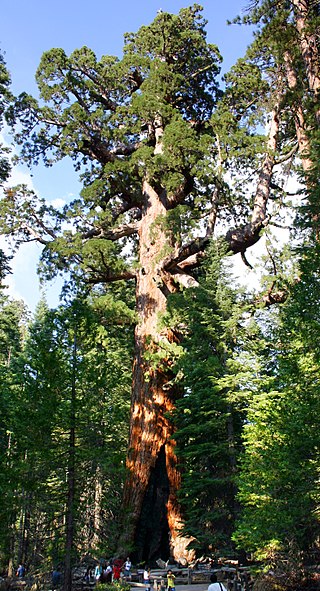
Sequoiadendron giganteum, also known as the giant sequoia, giant redwood or Sierra redwood is a coniferous tree, classified in the family Cupressaceae in the subfamily Sequoioideae. Giant sequoia specimens are the most massive trees on Earth. They are native to the groves on the western slopes of the Sierra Nevada mountain range of California but are grown around the world.
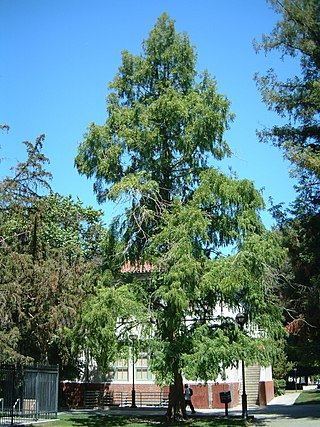
Metasequoia glyptostroboides, the dawn redwood, is a fast-growing, endangered deciduous conifer. It is the sole living species of the genus Metasequoia, one of three genera in the subfamily Sequoioideae of the family Cupressaceae. It now survives in the wild only in wet lower slopes and montane river and stream valleys in the border region of Hubei and Hunan provinces and Chongqing municipality in south-central China, notably in Lichuan county in Hubei. Although the shortest of the redwoods, it can grow to 167 ft (51 m) in height.

Betula pendula, commonly known as silver birch, warty birch, European white birch, or East Asian white birch, is a species of tree in the family Betulaceae, native to Europe and parts of Asia, though in southern Europe, it is only found at higher altitudes. Its range extends into Siberia, China, and southwest Asia in the mountains of northern Turkey, the Caucasus, and northern Iran. It has been introduced into North America, where it is known as the European white birch or weeping birch and is considered invasive in some states in the United States and parts of Canada. The tree can also be found in more temperate regions of Australia.

Betula nigra, the black birch, river birch or water birch, is a species of birch native to the Eastern United States from New Hampshire west to southern Minnesota, and south to northern Florida and west to Texas. It is one of the few heat-tolerant birches in a family of mostly cold-weather trees which do not thrive in USDA Zone 6 and up. B. nigra commonly occurs in floodplains and swamps.
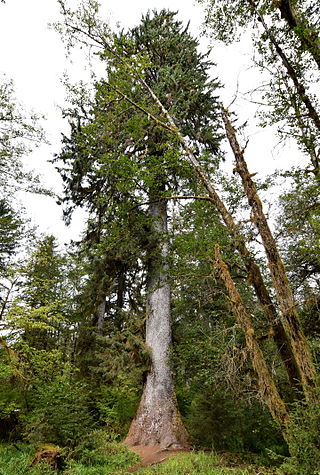
Picea sitchensis, the Sitka spruce, is a large, coniferous, evergreen tree growing to almost 100 meters (330 ft) tall, with a trunk diameter at breast height that can exceed 5 m (16 ft). It is by far the largest species of spruce and the fifth-largest conifer in the world, and the third-tallest conifer species. The Sitka spruce is one of the few species documented to exceed 90 m (300 ft) in height. Its name is derived from the community of Sitka in southeast Alaska, where it is prevalent. Its range hugs the western coast of Canada and the US, continuing south into northernmost California.

Nothofagus antarctica is a deciduous tree or shrub native to southern Chile and Argentina from about 36°S to Tierra del Fuego, where it grows mainly in the diminishing temperate rainforest.

Eucryphia is a small genus of trees and large shrubs native to the south temperate regions of South America and coastal eastern Australia, mainly Tasmania. Sometimes placed in a family of their own, the Eucryphiaceae, more recent classifications place them in the Cunoniaceae. There are seven species, two in South America and five in Australia, and several named hybrids.

Conocarpus erectus, commonly called buttonwood or button mangrove, is a species of mangrove shrub in the family Combretaceae.

Tsuga heterophylla, the western hemlock or western hemlock-spruce, is a species of hemlock native to the west coast of North America, with its northwestern limit on the Kenai Peninsula, Alaska, and its southeastern limit in northern Sonoma County, California. The Latin species name means 'variable leaves'.
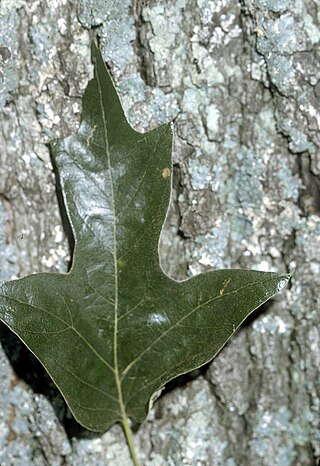
Quercus falcata, also called southern red oak, spanish oak, bottomland red oak or three-lobed red oak is an oak. Native to the southeastern United States, it gets its name the "Spanish Oak" as these are the areas of early Spanish colonies, whilst "southern red oak" comes from both its range and leaf color during late summer and fall. The southern red oak is a deciduous angiosperm, so has leaves that die after each growing period and come back in the next period of growth.

Ulmus rubra, the slippery elm, is a species of elm native to eastern North America. Other common names include red elm, gray elm, soft elm, moose elm, and Indian elm.
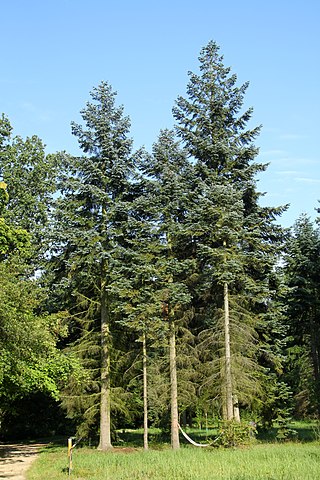
Abies procera, the noble fir, also called red fir and Christmas tree, is a species of fir native to the Cascade Range and Pacific Coast Ranges of the northwestern Pacific Coast of the United States. It occurs at altitudes of 300–1,500 meters (980–4,920 ft).

Ulmus gausseniiW. C. Cheng, the Anhui, or hairy, elm, is a medium size deciduous tree whose natural range is restricted to the valleys of the Langya limestone mountains of Chu Xian in Anhui Province, eastern China. The tree was most commonly found on the flood plains, indicating a tolerance of periodic inundation. However, U. gaussenii is now possibly the rarest and most endangered elm species, with only approximately 30 trees known to survive in the wild in 2009.
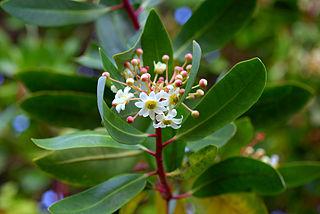
Drimys winteri, also known as Winter's bark, foye and canelo, is a slender species of tree in the family Winteraceae, growing up to 20 m (66 ft) tall. It is native to the Magellanic and Valdivian temperate forests of Chile and Argentina, where it is a dominant tree in the coastal evergreen forests. It is found below 1,200 m (3,900 ft) between latitude 32° south and Cape Horn at latitude 56°. In its southernmost natural range it can tolerate temperatures down to −20 °C (−4 °F). The plant is renowned for its phenotypic plasticity being able to grow in different sites from "extreme arid zones to wetlands along Chile". The tree does also grow in places with various types and degrees of competition from other plants.

Weinmannia trichosperma, the tineo, is an evergreen tree in the family of Cunoniaceae, it is native to Chile and Argentina: 35 to 47°S. endemic to laurel forest habitat.

Betula cordifolia, the mountain paper birch or heartleaf birch is a birch species native to Eastern Canada and the Northeastern United States. Until recently it was considered a variety of Betula papyrifera, with which it shares many characteristics, and it was classified as B. papyrifera var. cordifolia (Regel) Fern.
Hymenaea martiana is a tree species in the genus Hymenaea found in Brazil and Paraguay.

Eucryphia glutinosa, the brush bush or nirrhe, is a species of flowering plant in the family Cunoniaceae, native to moist woodland habitats in Chile. It is a large deciduous shrub or small tree, growing to 10 m (33 ft) tall by 6 m (20 ft) wide, with glossy dark green leaves turning red in autumn. Single four-petalled, fragrant white flowers with prominent stamens appear in late summer.

Ceriops tagal, commonly known as spurred mangrove or Indian mangrove, is a mangrove tree species in the family Rhizophoraceae. It is a protected tree in South Africa. The specific epithet tagal is a plant name from the Tagalog language.

Gilbertiodendron dewevrei is a species of tree in the family Fabaceae, native to tropical rain forests in Central Africa. It is often the dominant tree species of the Guineo-Congolian rainforest. The timber is traded as limbali, and is used for construction, flooring and railway sleepers. It is also used for making boats, furniture, tool handles and joinery and for making charcoal.
